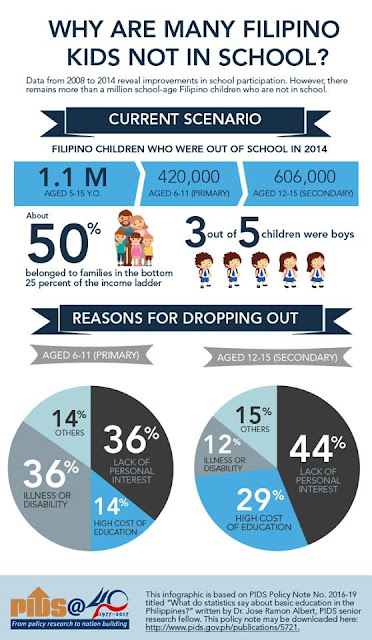Poverty and School Dropouts
The disparity is clear. The Philippine Institute for Development Studies (PIDS) shows that about half of school dropouts in the Philippines belong to the lowest 25 percentile in income. These families comprise only a fourth of the Philippine society yet their children make up half of school leavers. Poor children comprising the majority of out-of-school children, however, more than highlights the dramatic impact of poverty on basic education. The sad plight of poor children also marks the great inequity in Philippine schools. Finnish education expert Pasi Sahlberg just visited Thailand and pointed out that the biggest problems in Thailand's basic education are inequity and lack of competent teachers. These problems obviously apply likewise to the Philippines. Sadly, instead of addressing these problems, the Philippine government simply made the system much more inequitable with its new K to 12 curriculum.
PIDS provides the following to summarize their most recent findings:
Most dropouts lack interest. Poverty restricts one's view of the future. Poor children have less opportunities. They have less time and resources to discover their passion and interests. Their parents are regularly worried regarding basic needs, shelter and food. And most importantly, poor children go to schools different from schools attended by children of the elite and education policy makers. In the schools attended by the poor, the curriculum is too narrow, one that no longer includes the arts, music, recess and sports, but only focuses on math, reading and social studies. This does not specifically cater to the needs of poor children.
Disabilities or illness has also become a major reason behind leaving school. A gender gap, more boys are quitting school, is equally alarming. The PIDS is reporting that there is a drop in the number of school leavers. The accuracy of this comparison, however, is questionable since the reporting system in 2008 is different from that of 2015. In addition, the decrease in the dropout rate is seen primarily in the elementary years.
What is clearly more reliable than the absolute numbers is the demographic data of the school dropouts since this is not dependent on counting dropouts correctly. A representative slice of school leavers can already yield this information. In these terms, the following requires attention. Disabilities or illness has now become a major reason behind leaving school. Why this has happened is perplexing. A gender gap, more boys are quitting school, is equally alarming. The situation therefore remains disconcerting.
PIDS provides the following to summarize their most recent findings:
Most dropouts lack interest. Poverty restricts one's view of the future. Poor children have less opportunities. They have less time and resources to discover their passion and interests. Their parents are regularly worried regarding basic needs, shelter and food. And most importantly, poor children go to schools different from schools attended by children of the elite and education policy makers. In the schools attended by the poor, the curriculum is too narrow, one that no longer includes the arts, music, recess and sports, but only focuses on math, reading and social studies. This does not specifically cater to the needs of poor children.
Disabilities or illness has also become a major reason behind leaving school. A gender gap, more boys are quitting school, is equally alarming. The PIDS is reporting that there is a drop in the number of school leavers. The accuracy of this comparison, however, is questionable since the reporting system in 2008 is different from that of 2015. In addition, the decrease in the dropout rate is seen primarily in the elementary years.
What is clearly more reliable than the absolute numbers is the demographic data of the school dropouts since this is not dependent on counting dropouts correctly. A representative slice of school leavers can already yield this information. In these terms, the following requires attention. Disabilities or illness has now become a major reason behind leaving school. Why this has happened is perplexing. A gender gap, more boys are quitting school, is equally alarming. The situation therefore remains disconcerting.
 |
| Above copied from Philippine Institute for Development Studies. What do statistics say about basic educationin the Philippines? 2016. |

Comments
Post a Comment